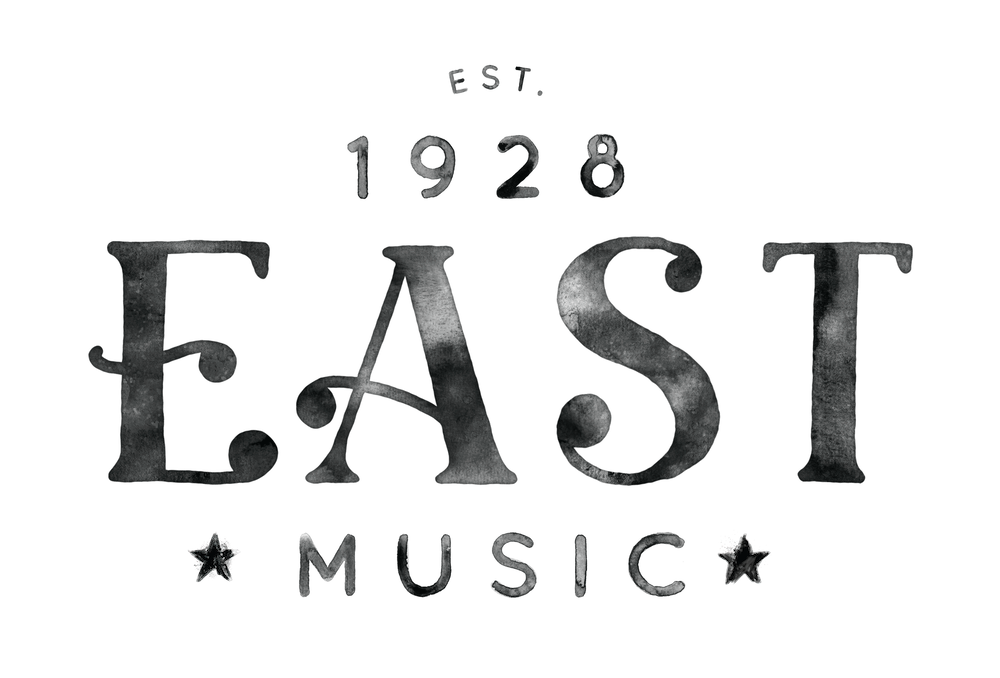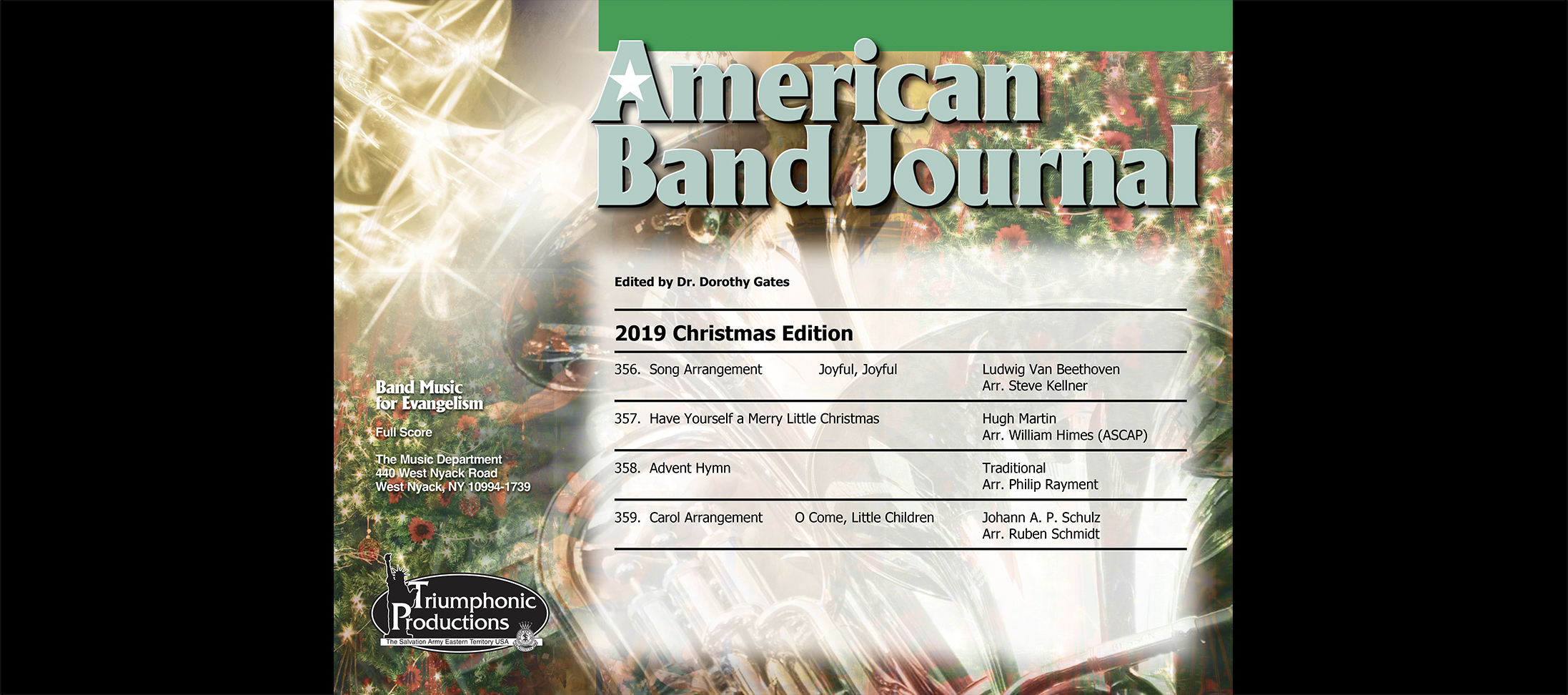AMERICAN BAND JOURNAL 83rd EDITION
No. 356—359
Edited by Dr. Dorothy Gates
PREFACE
We are once again pleased to release the next edition of the Christmas American Band Journal. The Christmas season is a special time for us to tell the wonderful story of Jesus and this music will certainly help convey our message and ring you into the true spirit of Christmas. This year we are pleased to add four pieces to the American Band Journal. Ruben Schmidt brings to life “O, Come Little Children” with a fun new arrangement that will add variety to any concert program. Steve Kellner is making his ABJ debut with “Joyful, Joyful” that would make an excellent concert opener during the Christmas season and beyond. Also making his ABJ debut, Philip Rayment offers up “Advent Hymn” which is a beautiful arrangement of “O Come Immanuel”. This will quickly become a staple of brass band Christmas music for years to come. Rounding out our journal is William Himes with a wonderful new arrangement of “Have Yourself a Merry Little Christmas”. We are very pleased with the standard of music presented and we’re sure that these pieces will enhance your music ministry during the Christmas season.
Derek W. Lance
Territorial Music Secretary
Available for purchase HERE.
INSTRUMENTATION
Though nine instrumentalists may adequately present this music, it is designed to work equally well or better with full concert band, orchestra or brass band instrumentation. For nine brass instrumentalists, two cornetists should be assigned to the first cornet part because of the frequent use of divisi, with one second cornet, two horns, two trombones, one euphonium, and one tuba completing the minimum group. The optional parts – soprano cornet, flugel horn, baritone, bass trombone and percussion – are all included in the score. The music is complete without these parts, but their use will greatly enhance the performance as long as the fundamental parts are covered. Download complimentary transposed parts in F and C (TC/BC) online via: www.music.saconnects.org.
PROGRAM NOTES AND NOTES TO THE CONDUCTOR
No. 356 SONG ARRANGEMENT – JOYFUL, JOYFUL
LUDWIG VAN BEETHOVEN, ARR. STEVE KELLNER
Program Note
This exuberant hymn of praise is first in many denominational hymnals and rightly so, with a poetically expressive text by Henry van Dyke and music by Beethoven. Written as a congregational accompaniment, this arrangement also serves as a “young person’s guide to the brass band” featuring all the sections of the band and showing the wide range of colors and moods possible in brass band music.
Note to the Conductor
The marked tempo is for congregational accompaniment. If the piece is played as a stand-alone band feature it can be played faster. The introduction will require perhaps the most rehearsal of anything in the arrangement as there are some sudden modulations and lots of accidentals. In general, the hymn tune itself is played cantabile throughout (with the exception of Letter D) but the accompanying figures feature a variety of articulations, so insist on a clear distinction. For example, make sure that the bell tone figures in the cornets and flugelhorn at Letter B are equal in balance and articulation and contrast with the legato tune in the trombones. At Letter D note that the tune is marked up a dynamic level from the accompanying figures so that the congregation can clearly hear it. The horns and baritones should think of themselves as “bells up” French horns from here until the end of the piece. Song leaders should note that the last phrase of this verse is repeated and slightly augmented. Depending on the availability of and number of players on the optional parts conductors may need to adjust the dynamics to achieve optimum balance.
No. 357 HAVE YOURSELF A MERRY LITTLE CHRISTMAS
HUGH MARTIN, ARR. WILLIAM HIMES (ASCAP)
Program Note
This nostalgic Christmas song was first performed by Judy Garland in the 1944 movie Meet Me in St. Louis and quickly became popular among the United States troops serving in World War II. It has enjoyed lasting popularity ever since, having been recorded by many artists over the years including Frank Sinatra, Bing Crosby, Doris Day, Ella Fitzgerald and James Taylor. In 2004 the American Film Institute included it in its list of the top 100 songs in American cinema.
Note to the Conductor
This is a popular holiday song which can evoke many nostalgic memories. Therefore, strive for a warm, expressive and unhurried interpretation, making the most of this lyrical theme as it appears throughout the band. While Eb Soprano cues are provided, they are not essential and only should be played if there is a reasonable number of 1st Cornets. The same is true for the optional cup mute designation for 1st and 2nd Cornets at bars 43-46. The idea is to have one player for each part play the muted part (much in the style of pizzicato violins) with the remaining cornets ready to play without mutes leading into bar 47. In other words, a smaller ensemble can ignore the mute designation here.
No. 358 ADVENT HYMN
TRADITIONAL, ARR. PHILIP RAYMENT
Program Note
O Come, O Come Emmanuel (SASB #117) is an ancient hymn whose Latin text can be traced back to the 13th century, while the associated rune is rooted in 15th century France. John Mason Neale’s 1861 translation provides us with an Advent message that is equal parts longing and fulfillment. This arrangement focuses on the first, third and fourth verses, which attempt to convey the feelings of despair for a captive, sinful world under “Satan’s tyranny.” However, this is answered by the assurance that Emmanuel (God With Us) has come to “put death’s dark shadows to flight.” We are assured that God the Son has indeed come to us and yet we continue to pray for the second Advent when our Savior will return.
Note to the Conductor
This arrangement is intended to showcase the beautiful melody, and this should always have prominence. Much of the piece centers around running eighth note figures and the ensemble will need to take care to line these up, especially when the tempo changes. It is preferable to have at least two basses when performing this piece. Watch carefully for cues to cover important color or bass parts in smaller ensembles. The introduction should be mysterious, with the first horn giving due weight to the lower pitches at the beginning of phrases. If tubular bells are not available, there should be no substitutions. A Section should be simple in its presentation, as in a plainchant. The approach can be broadened significantly at the refrain, four measures before B Section. At B, there should be more motion and a feeling of angst. Allow the mournful counter-melody in the euphonium and baritone to come through. The bass melody at C should be as smooth and sonorous as possible. A well-graded crescendo will bring the work to its climactic “Rejoice!” at letter D. Be sure to sustain intensity right up to the fermata. A short coda ends the piece with the music gradually fading away to a mysterious conclusion.
No. 359 CAROL ARRANGEMENT – O COME, LITTLE CHILDREN
JOHANN A.P. SCHULZ, ARR. RUBEN SCHMIDT
Program Note
O Come, little Children is a light jazz arrangement of the old German Christmas Carol which features the words:
O Come, little children, O come, one and all
O come ye to Bethlehem’s cradle and stall,
And see what the Father in heaven so true
Has done to prepare a bright Christmas for you.
Behold in the manger, that strange little bed,
A child, sweet and gentle, is resting his head,
A Babe, clad in garments so pure and white,
And fairer by far than the angels of light.
Note to the Conductor
Keep the tempo driving and light throughout the whole piece. Make the most of the dynamic contrasts and make sure the melody comes through at all times. Rhythmical figures should be always tight and perfectly together, for example Cornets and Trombones at letter C or the accompaniment at letter F..
ADAPTING THE AMERICAN BAND JOURNAL FOR CONCERT BAND OR ORCHESTRA
The following will be a helpful guide to musical directors who use the ABJ with their
concert band or orchestra. Contact the Eastern Territorial Music Department via
telephone at (845) 620-7444 or online at www.music.saconnects.org for a free set
of transposed parts.
Instrument
Flute
Oboe
English Horn
Bassoon
Eb Soprano Clarinet
Bb Clarinet 1
Bb Clarinet 2,3
Eb Alto Clarinet
Bb Bass Clarinet
Eb Contra Alto Clarinet
Bb Contra Bass Clarinet
Eb Alto Saxophone 1
Eb Alto Saxophone 2
Bb Tenor Saxophone
Eb Baritone Saxophone
Violin
Viola
Cello
String Bass
Keyboard
ABJ Part to Play
C Instrument (upper octaves)
C Instrument (lower octaves)
F Horn 1 or 2
Baritone, Euphonium or Tuba B.C.
Eb Soprano Cornet
Bb Cornet 1
Bb Cornet 2
Eb Horn 2
Bb Bass
Eb Bass
Bb Bass
Eb Horn 1
Eb Horn 2
Bb Baritone
Eb Bass
C Instrument (divisi)
Not provided
Baritone or Euphonium B.C.
Bass Tuba B.C.
C Instrument (in octaves)

